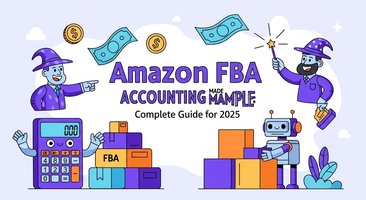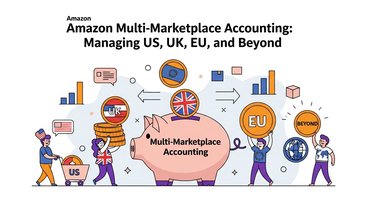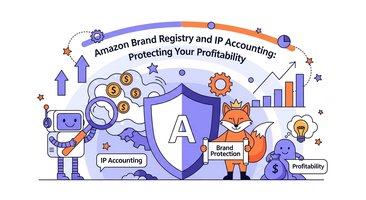Amazon's complex fee structure can make or break your profitability as an FBA seller. With over a dozen different fee types, seasonal variations, and category-specific rates, many sellers struggle to accurately track costs and optimize their pricing strategies. This comprehensive guide will help you understand, track, and optimize every Amazon fee to maximize your bottom line.
Understanding and properly accounting for Amazon seller fees is crucial for accurate profit calculations, pricing decisions, and tax compliance. Let's dive into the complete breakdown of Amazon's fee ecosystem and how to manage it effectively.
Amazon Fee Structure Overview
Amazon operates a multi-layered fee system designed to cover various services while maintaining marketplace quality. These fees fall into several categories, each requiring different accounting treatment and optimization strategies.
The complexity of Amazon's fee structure often catches new sellers off guard. Unlike traditional retail where you might have simple wholesale costs and overhead, Amazon sellers must account for:
- Variable fees that change based on product characteristics
- Time-sensitive fees that fluctuate seasonally
- Performance-based fees tied to seller metrics
- Optional fees for additional services
Understanding each fee type helps you make informed decisions about product selection, pricing strategies, and business operations.
Referral Fees: The Foundation of Amazon's Revenue
Amazon referral fees represent the largest cost component for most sellers, typically ranging from 6% to 45% of your item's sale price. Most product categories fall within the 8-15% range, making this your most significant ongoing expense.
Category-Specific Referral Rates
Different product categories have vastly different referral fee rates:
Low-Rate Categories (6-8%):
- Personal computers
- Consumer electronics
- Musical instruments
- Automotive parts
Standard Rate Categories (8-15%):
- Home and kitchen
- Sports and outdoors
- Books and media
- Clothing and accessories
High-Rate Categories (15-45%):
- Amazon device accessories (45%)
- Fine jewelry (20%)
- Luxury beauty (15%)
- Gift cards (20%)
Referral Fee Calculation Methods
Amazon calculates referral fees using different methods depending on the product category:
Percentage of Sale Price: Most categories use a straight percentage of the total sale price, including shipping charges.
Per-Item Fees: Some categories combine percentage fees with fixed per-item charges.
Tiered Pricing: Certain categories use tiered structures where rates decrease at higher price points.
Minimum Fees: Amazon imposes minimum referral fees (typically $0.30) regardless of the percentage calculation.
Accounting for Referral Fees
Proper referral fee accounting requires treating these costs as part of your cost of goods sold rather than operating expenses. This treatment provides accurate gross margin calculations and better profitability analysis.
When setting up your accounting system:
- Create separate COGS accounts for different fee types
- Track referral fees by product category
- Monitor rate changes that affect profitability
- Include referral fees in break-even calculations
FBA Fulfillment Fees: Size, Weight, and Seasonality
FBA fulfillment fees cover Amazon's picking, packing, and shipping services. These fees vary based on product dimensions, weight, and seasonal demand, making them one of the most complex fee categories to track and optimize.
Size Tier Classifications
Amazon classifies products into size tiers that determine fulfillment fees:
Small Standard-Size:
- Longest side ≤ 15 inches
- Median side ≤ 12 inches
- Shortest side ≤ 0.75 inches
- Weight ≤ 12 oz
Large Standard-Size:
- Longest side ≤ 18 inches
- Median side ≤ 14 inches
- Shortest side ≤ 8 inches
- Weight ≤ 20 lbs
Small Oversize:
- Longest side ≤ 60 inches
- Median side ≤ 30 inches
- Length + girth ≤ 130 inches
- Weight ≤ 70 lbs
Large Oversize:
- Exceeds small oversize dimensions
- Special handling requirements
Seasonal Fee Variations
Peak season surcharges significantly impact fulfillment costs during high-demand periods:
Peak Season Timing: October 15 - January 14
Standard Surcharge: $0.35 per unit for standard-size items
Oversize Surcharge: $1.00 per unit for oversize items
These seasonal variations require careful cash flow planning and pricing adjustments to maintain profitability during peak selling periods.
Optimizing Fulfillment Fees
Several strategies can help reduce fulfillment fees:
Product Packaging Optimization:
- Minimize packaging materials while ensuring protection
- Design products to fit lower size tiers
- Consider product bundling to improve per-unit economics
Dimensional Weight Management:
- Reduce packaging air space
- Use compact packaging designs
- Consider product design changes for better shipping efficiency
Storage Fees: Managing Your Inventory Investment
Amazon storage fees represent ongoing costs for housing your inventory in fulfillment centers. These fees vary by season and storage duration, requiring active inventory management to optimize costs.
Monthly Storage Fee Structure
Standard Storage Rates (January-September):
- Standard-size: $0.87 per cubic foot
- Oversize: $0.56 per cubic foot
Peak Storage Rates (October-December):
- Standard-size: $2.40 per cubic foot
- Oversize: $1.40 per cubic foot
The dramatic increase during peak season makes inventory planning crucial for maintaining profitability during Q4.
Long-Term Storage Fees
Amazon charges long-term storage fees for inventory older than 365 days:
- Annual fee: $6.90 per cubic foot
- Charged twice yearly: February 15 and August 15
- Automatic removal: Amazon may dispose of aged inventory
Storage Fee Optimization Strategies
Effective inventory management reduces storage costs:
Inventory Turnover Monitoring:
- Track inventory age and movement
- Identify slow-moving products early
- Plan promotional activities to clear aged inventory
Seasonal Planning:
- Reduce inventory levels before peak season rate increases
- Time product launches to avoid peak storage rates
- Consider temporary inventory removal during high-rate periods
Product Mix Optimization:
- Focus on products with higher turnover rates
- Evaluate storage costs in product profitability calculations
- Consider product lifecycle timing
Additional Amazon Fees and Charges
Beyond the primary fee categories, Amazon charges various additional fees that can impact profitability if not properly managed.
Return Processing Fees
Customer returns generate processing fees that vary by category:
- Apparel: $2.50-$5.00 per return
- Electronics: $3.00-$8.00 per return
- Home goods: $2.00-$6.00 per return
Unplanned Service Fees
When your inventory doesn't meet Amazon's preparation requirements, unplanned service fees apply:
- Labeling: $0.30 per item
- Polybagging: $0.10 per item
- Bubble wrapping: $0.15 per item
- Taping: $0.05 per item
Inventory Disposal and Removal Fees
Inventory removal and disposal generate additional costs:
- Removal fees: $0.50-$1.24 per item
- Disposal fees: $0.15-$0.30 per item
- Liquidation fees: Variable based on product value
Multi-Channel Fulfillment Fees
Using Amazon's fulfillment network for non-Amazon orders incurs higher fees:
- Standard shipping: 30-50% higher than FBA fees
- Expedited shipping: 50-80% premium over standard rates
Automated Fee Tracking and Categorization
Managing Amazon's complex fee structure manually becomes overwhelming as your business grows. Automated fee tracking ensures accuracy while saving significant time on bookkeeping tasks.
Manual Tracking Challenges
Manual fee management creates several problems:
- Time-intensive data entry and categorization
- High risk of errors in complex calculations
- Difficulty tracking trends and optimizations
- Inconsistent accounting treatment across fee types
Automation Benefits
Automated fee tracking provides numerous advantages:
Accuracy Improvements: Automated systems consistently apply proper categorization rules and catch discrepancies that manual processes miss.
Time Savings: Eliminate hours of manual data entry while ensuring all fees are properly recorded and categorized.
Real-Time Insights: Access current profitability data to make informed decisions about pricing, inventory, and product mix.
Scalability: Handle increased transaction volume without proportional increases in accounting workload.
Klavena's Automated Fee Management
Klavena specializes in Amazon fee automation with features designed specifically for FBA sellers:
Automated Transaction Categorization: All Amazon fee types are automatically identified and properly categorized according to accounting best practices.
Real-Time Cost Tracking: Monitor fee impacts on profitability as they occur, enabling quick responses to cost changes.
Historical Trend Analysis: Track fee patterns over time to identify optimization opportunities and seasonal variations.
Integration with Financial Reporting: Fee data flows directly into profit and loss statements and product profitability reports.
Fee Optimization Strategies
Understanding fees is only the first step—optimizing fee costs requires strategic thinking about product selection, pricing, and operations.
Product Selection Optimization
Fee-conscious product selection improves overall profitability:
Category Analysis: Focus on categories with lower referral fee rates when possible, but balance this against market demand and competition.
Size and Weight Optimization: Design or source products that fit into lower-cost fulfillment tiers while meeting customer needs.
Return Rate Consideration: Research historical return rates for product categories and factor these costs into profitability calculations.
Pricing Strategy Integration
Fee-aware pricing ensures sustainable profitability:
Dynamic Pricing Models: Adjust prices based on seasonal fee variations and competitive positioning.
Bundle Strategies: Create product bundles that improve per-unit economics by spreading fixed fees across multiple items.
Value-Based Pricing: Focus on products where customers are willing to pay premiums that cover higher fee structures.
Operational Efficiency Improvements
Operational optimization reduces controllable fees:
Inventory Management: Maintain optimal inventory levels to minimize storage fees while avoiding stockouts.
Product Preparation: Ensure products meet Amazon's requirements to avoid unplanned service fees.
Return Minimization: Improve product descriptions, images, and quality to reduce return rates and associated fees.
Monitoring and Reporting Best Practices
Effective fee monitoring requires systematic tracking and regular analysis of fee trends and impacts.
Key Performance Indicators
Track these essential metrics for fee optimization:
Fee Percentage of Revenue: Monitor total fees as a percentage of gross sales to identify trends.
Fee Cost Per Unit: Calculate average fees per unit sold to understand unit economics.
Category Performance: Compare fee impacts across different product categories.
Seasonal Variations: Track how seasonal rate changes affect profitability.
Regular Review Processes
Implement systematic review processes for ongoing optimization:
Monthly Fee Analysis: Review fee trends and identify optimization opportunities.
Quarterly Strategy Reviews: Assess product mix and pricing strategies based on fee performance.
Annual Planning: Incorporate fee projections into business planning and budgeting processes.
Competitive Benchmarking: Compare your fee efficiency against industry benchmarks and competitors.
Tax Implications of Amazon Fees
Proper tax treatment of Amazon fees ensures compliance while maximizing deductions.
Deductible Business Expenses
Most Amazon fees qualify as deductible business expenses:
- Referral fees: Deductible as cost of goods sold
- Fulfillment fees: Deductible as shipping and fulfillment expenses
- Storage fees: Deductible as inventory carrying costs
- Advertising fees: Deductible as marketing expenses
Record Keeping Requirements
Maintain detailed records for tax compliance:
- Monthly settlement reports from Amazon
- Fee categorization documentation
- Product-specific cost tracking
- Annual fee summaries by category
Future-Proofing Your Fee Management
Amazon regularly updates its fee structure, making adaptability crucial for long-term success.
Staying Current with Changes
Monitor fee updates through multiple channels:
- Amazon Seller Central announcements
- Industry publications and forums
- Professional service provider updates
- Automated system notifications
Building Flexible Systems
Design adaptable processes that can handle fee structure changes:
- Use accounting systems that can accommodate new fee types
- Maintain flexible pricing models that can adjust to fee changes
- Build relationships with service providers who stay current with Amazon policies
Conclusion
Mastering Amazon fee tracking and optimization is essential for building a profitable FBA business. The complexity of Amazon's fee structure requires systematic approaches to tracking, categorization, and optimization.
Success requires combining thorough understanding of fee structures with automated tracking systems and strategic optimization efforts. While the complexity can seem overwhelming, proper systems and processes make fee management manageable while providing competitive advantages through better cost control.
Klavena's automated fee categorization eliminates the manual complexity of Amazon fee tracking while providing the insights needed for strategic optimization. By automating the tracking process, sellers can focus on strategic decisions that drive profitability rather than getting bogged down in manual bookkeeping tasks.
Whether you're just starting with Amazon FBA or looking to optimize an existing business, investing in proper fee tracking and optimization systems will pay dividends through improved profitability and better business decision-making capabilities.





